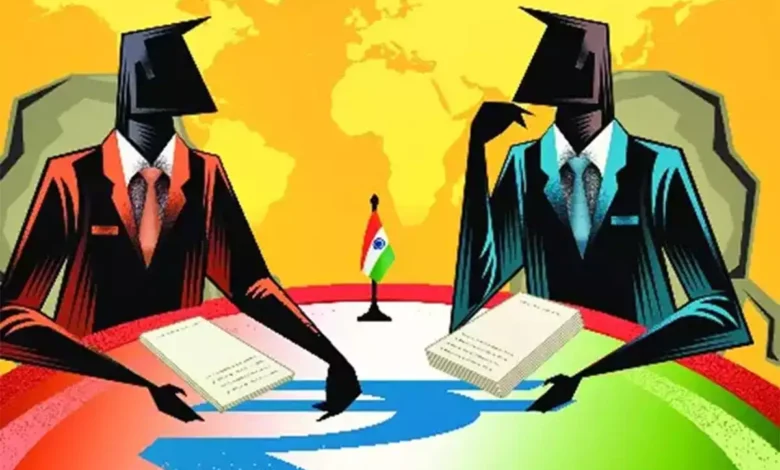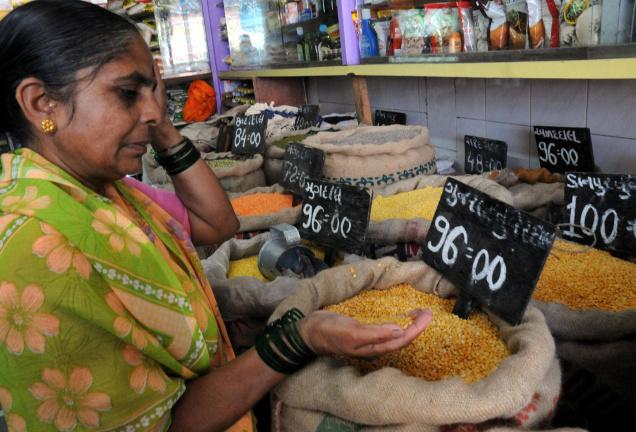GDP Growth Likely To Fall 6 Quarter Low Of 6%, Food Inflation Show No Signs Of Easing; The Indian Economy May Be Doing Well But Not The Majority Of Indians!
India's economy seems to be shining on paper, with many impressive macroeconomic indicators and high growth forecasts; however, behind these gleaming numbers, the reality for the average Indian is contrastingly different. The economy appears to be on an upward swing, yet many Indians are still struggling to reap the benefits of this so-called success.

India’s economy in the first quarter of FY2025 is set for a slowdown, with ICRA projecting a year-on-year GDP growth of just 6.0%, marking a six-quarter low.
The same is a notable decline from the 7.8% growth recorded in the final quarter of FY2024 and is driven by a contraction in government capital expenditure and a dip in urban consumer confidence.
The estimate from ICRA contrasts sharply with the RBI’s more optimistic projection of a 7.1% GDP growth for the same period; hence, the deviation in these forecasts indicates the economic challenges facing the country.
ICRA has attributed this slowdown to a combination of factors, including a temporary lull in economic activity in certain sectors due to the Parliamentary elections and sluggish government capital expenditure at both the central and state levels.
The impact of these factors has been compounded by a surprising dip in urban consumer confidence, as reflected in the RBI’s Consumer Confidence Survey rounds from May and July 2024.
Moreover, the lingering effects of last year’s unfavorable monsoon and an uneven start to the 2024 monsoon season have also dampened rural sentiment, thus preventing a broader economic recovery.
)
Additionally, the industrial sector has faced headwinds, with lower volume growth and diminishing gains from commodity prices impacting profitability in some segments.
ICRA’s analysis suggests that the growth in Gross Value Added (GVA), a key measure of economic productivity, is likely to ease to 5.7% in Q1 FY2025, down from 6.3% in the previous quarter.
The decline is expected to be driven primarily by the industrial sector, with a mild easing in the services sector and a slight improvement in agricultural GVA growth.
The gap between GDP and GVA growth is also anticipated to narrow, reflecting a lower expansion in net indirect taxes and a turnaround in government subsidy outgo.
The extreme heatwave experienced during the quarter further aggravated the challenges, affecting footfalls in various service sectors even as it drove up electricity demand.
On balance, ICRA foresees a transient moderation in India’s economic growth in Q1 FY2025, with GDP and GVA growth estimated at 6.0% and 5.7%, respectively.
Looking ahead, ICRA remains cautiously optimistic about the full-year prospects for FY2025.
The agency expects a back-ended pickup in economic activity, driven by a significant expansion in government capital expenditure, which will be crucial for achieving the budgeted estimates.
The agency projects that GDP and GVA growth for FY2025 will rise to 6.8% and 6.5%, respectively, assuming that the government can meet its ambitious capital expenditure targets in the latter half of the fiscal year.
Persistent Food Inflation Poses Ongoing Challenge for RBI’s Monetary Policy
The RBI is facing mounting pressures from persistent food inflation, which shows little sign of abating in the near term.
During the Monetary Policy Committee (MPC) meeting held from August 6 to 8, RBI Governor Shaktikanta Das emphasized the need for vigilance against the potential spillovers of food price pressures into the broader economy.
In its August monetary policy review, the MPC, by a 4:2 majority, decided to keep the repo rate unchanged at 6.5% for the ninth consecutive time; the decision was driven by the ongoing risk posed by high food inflation, which remains a significant concern for the central bank.
Governor Das, who supported maintaining the current rate, noted that while headline inflation for July and the second quarter of FY2024-25 (July-September) might benefit from a base effect, the stubborn persistence of food inflation and rising household inflation expectations necessitate continued vigilance in monetary policy.
Das pointed to factors that could potentially alleviate food inflation, such as a good monsoon, steady improvement in kharif sowing, rising reservoir levels, and a potentially favorable rabi season output.
However, he also warned of uncertainties stemming from the frequent occurrence of adverse weather events, geopolitical tensions, and financial market volatility.
These factors, coupled with the observation that core inflation may have bottomed out, underline the complexity of the current inflationary environment.

No Signs Of Easing Monetary Policy
The Governor also dismissed the idea of easing monetary policy based on theoretical constructs like the equilibrium natural interest rate, arguing that policy decisions should be grounded in real-world conditions.
He emphasized that any justification for policy easing based on so-called high real rates could be misleading, particularly when achieving durable disinflation remains a work in progress.
On the growth front, Das expressed optimism, noting that India is on a steady growth path, driven primarily by domestic factors.
The pickup in agricultural activity is expected to further boost rural consumption, while urban consumption remains steady.
Government capital expenditure remains strong, and private corporate investment is gaining momentum, with capacity utilization reaching its highest level in 11 years.
The healthy balance sheets of banks and corporates provide a favorable environment for private sector investments to accelerate.
However, not all MPC members shared this optimism.
RBI Deputy Governor Michael Patra, who also voted to keep the policy rate unchanged, highlighted the widening gap between headline and food inflation, which he argued was stalling the alignment of overall inflation with the RBI’s target.
External MPC member Ashima Goyal, in contrast, voted for a 25 basis points (bps) cut in the repo rate and a change in stance to neutral, reflecting her concern about the impact of restrictive monetary policy on growth.
Another external member, Jayanth Varma, echoed Goyal’s concerns, noting that the MPC’s restrictive stance could be sacrificing growth.
He pointed out that despite India’s projected growth rates for 2024-25 and 2025-26 being among the highest in the world, they remain significantly below the country’s potential growth rate of at least 8%.
The shortfall, he argued, is insufficient to meet the aspirations of the new entrants into the workforce during India’s demographic transition.
Varma also voted for a 25 bps reduction in the repo rate and a change in stance to neutral.
MPC member Rajiv Ranjan emphasized the persistence of food inflation, which has averaged 8% since July 2023 and contributed to approximately 75% of headline inflation during April-June 2024.
He stressed the importance of addressing these persistent pressures, given the high share of food in the household consumption basket and the risk of its spillovers into non-food core CPI components.
Shashanka Bhide, another MPC member, underscored the necessity of a progressive decline in food inflation to achieve the RBI’s 4% headline inflation target sustainably.
The Indian Economy May Be Doing Well, But Not the Majority of Indians
India’s economy is shining on paper, with a string of impressive macroeconomic indicators and high growth forecasts. Yet, behind the gleaming numbers, the reality for the average Indian is starkly different. While the economy appears to be on an upward trajectory, many Indians are still struggling to reap the benefits of this so-called success.
Economic Indicators Flashing Green, But….
India’s economy has been exceeding expectations, with GDP growth rates defying the predictions of many skeptics.
The government anticipated a 7.6% GDP growth for the last financial year, and as we move further into 2023-24, forecasts are trending upwards.
The Reserve Bank of India (RBI) and the Asian Development Bank both predict a 7% growth for the fourth consecutive year, while the International Monetary Fund (IMF) has raised its growth forecast for 2024-25 to 6.8%.
These figures place India in an enviable position globally, especially at a time when the world economy is facing significant headwinds.
The Real Question Of Per Capita Income
India’s sustained growth has given its economy a heft that it did not possess before.
The IMF projects India’s GDP for 2024 to be nearly $3.94 trillion, bringing it close to Japan’s $4.11 trillion and not far behind Germany’s $4.59 trillion. This positions India as a potential contender for the third-largest economy in the world within a few years, a significant achievement by any measure.
However, this achievement is less impressive when we consider per capita income.
At $10,123, measured using purchasing power parity (PPP), India’s per capita income is only 43% of the world average and ranks an unflattering 125th globally.
In nominal dollars, India’s per capita income is among the lowest of the 50 largest economies, only slightly ahead of Bangladesh and Cambodia showing a significant disparity between the overall economic growth and the standard of living for the average Indian.

The Other Side of the Story
However, despite the rosy macroeconomic picture, a closer look reveals a less flattering story.
India’s recent growth must be viewed in the context of the significant contraction during the COVID-19 pandemic, where the economy shrank by 5.8% in 2020-21 and grew by only 4% the year before that.
Over the five years from 2019 to 2024, the average annual growth has been just 4.5%, the slowest in three decades.
Even when considering the Modi government’s entire decade in power, growth has lagged behind the previous decade under Manmohan Singh, though the comparison may be somewhat unfair due to the pandemic’s impact.
Moreover, the economy has become more inward-looking, with a sharp reduction in the ratio of external trade to GDP. Exports of goods and services have shrunk to about 21% of GDP from 30%, a worrying trend for a country that aspires to rapid growth.
Investment trends also paint a concerning picture, with overall fixed capital formation recovering only now to match the levels of 2013-14. Foreign direct investment (FDI) has declined sharply for two consecutive years, and private investment remains sluggish.
Consumption Slowdown and Rising Debt
The consumption slowdown is another red flag, partly driven by the sharp rise in household debt.
Private banks and fintech companies have increasingly lent to individuals rather than corporations, leading to a surge in unsecured credit that pushed household debt to an all-time high relative to GDP, prompting the RBI to intervene.
Public debt is also high, at 82% of GDP, which will constrain future government borrowing and potentially curtail the capital expenditure on infrastructure that has driven recent growth.
)
The Disparity in Wealth Distribution
While corporate profits are at near all-time highs relative to GDP, and the stock market is booming, these gains have not translated into widespread prosperity.
The surge in demat accounts and mutual fund folios suggests a growing participation in financial markets, but this is still limited to a relatively small segment of the population.
The majority of Indians remain untouched by this financialization, struggling with stagnant incomes, rising costs, and limited access to quality education, healthcare, and job opportunities.
India’s Economic Future
India’s economy has long been the subject of both optimistic projections and cautious skepticism.
With an economy that has traditionally grown at over 6% in the last three decades, there is growing hope among some that the country could ascend to a new growth trajectory, reaching a long-term growth rate of 7% or more over the next 25 years.
However, as the country faces various structural constraints and global uncertainties, the path to sustained high growth remains fraught with challenges.
The Optimistic Vision
For those optimistic about India’s future, the potential for rapid economic expansion seems within reach.
Even without significant acceleration, India’s economy—already nearing the $4 trillion mark—could double in size to $8 trillion in less than 12 years. With population growth slowing to under 1%, the prospect of per capita income doubling to $5,500 within the next 15 years places India firmly in the upper-middle-income bracket.
The story of a growing economy has fueled global enthusiasm, with many seeing India as a giant economy in the making.

The Middle-Income Trap and Other Challenges
However, the question is- Can India maintain this rapid growth without encountering significant hurdles?
Historical precedents from other emerging economies, such as Russia and Brazil, are today cautionary tales – once fast-growing, these economies have hit roadblocks and crises, preventing them from realizing their full potential.
India, currently a lower-middle-income country, may not face the middle-income trap immediately, but the possibility looms on the horizon as it aims to transition to a higher-middle-income status by 2030.
Structural Constraints
Several structural constraints threaten to derail India’s growth direction.
The country continues to struggle with poor educational outcomes, subpar health metrics, and a failure to shift surplus agricultural workers into more productive sectors like manufacturing and services.
Furthermore, India’s heavy reliance on external energy sources leaves it vulnerable to global fluctuations.
The Impact of Economic Policy Choices
India’s decision to stay out of the Regional Comprehensive Economic Partnership (RCEP), a major trading bloc in East Asia, could prove to be a significant misstep.
Hence, by pursuing a strategy of self-reliance and import substitution under the banner of ‘Atmanirbhar Bharat,‘ India risks being excluded from key supply chains in one of the world’s most dynamic regions.
Historically, no country has achieved sustained rapid growth without also experiencing rapid export growth. Yet, over the past decade, India’s goods exports have grown at a meager annual rate of 3.5%, indicating a failure to boost manufacturing output and exports.
Comparisons with smaller nations like Vietnam and Bangladesh further indicate India’s challenges. Both countries have outpaced India in export growth, particularly in sectors like electronics, apparel, and footwear—areas that India has identified as priorities.
Despite Vietnam’s smaller population and economy, its goods exports are now on par with India’s non-oil exports, and its per capita income exceeds India’s by 50%.
A Reality Check
India’s macroeconomic performance has been commendable, with growth rates more than double the global average and stable economic indicators. However, the benefits of this growth have not been evenly distributed.
Periodic surveys of employment, household consumption, and wage levels indicate that life for many Indians has not improved in recent years. This reality calls into question the triumphalism that often accompanies discussions of India’s economic performance.

K-Shaped Growth
In the wake of the Covid-19 pandemic, India’s economy has revealed a troubling K-shaped recovery, where the benefits of growth are unevenly distributed across different segments of society.
This phenomenon shows a widening disparity in economic well-being and the challenges faced by various income groups in the post-pandemic world.
Consumption and Debt Dynamics
The slowdown in private consumption is partly attributable to rising household debt with higher debt levels—often associated with real estate, vehicles, and education—discretionary spending has diminished.
Government data reveal a shift toward investment-driven growth, predominantly fueled by increased capital spending from the union budget.
Although this approach has led to a significant rise in public sector investment, private corporate investment has lagged, initially focused on debt reduction rather than expansion.
Recent signs of increased private investment could signal a potential turnaround, but its sustainability remains uncertain.
Premium vs. Basic Consumption
The consumption data reveal a K-shaped recovery in action.
Companies focusing on premium products have fared better than those targeting lower-income consumers. For example, car sales have outpaced those of two-wheelers, and premium brands have driven growth for companies like Nestlé.
This divergence indicates how the economic recovery has benefited higher-income individuals more than those at the lower end of the income spectrum.

Rising Inequality
The growing inequality is a significant concern, with recent reports indicating that India now has higher inequality levels than during colonial rule.
The top 1% of income earners command a substantial share of income and wealth, reflecting a skewed distribution of economic gains; despite this, the political discourse has largely focused on poverty reduction rather than addressing inequality directly.
Government surveys report a dramatic drop in absolute poverty, with more than 250 million people reportedly moving above the poverty line.
Reevaluating Poverty Metrics
While poverty reduction is a notable achievement, the current poverty line used by the Indian government is considered overly modest.
For a country with India’s economic stature, a higher and more realistic definition of poverty is necessary.
The World Bank’s poverty yardstick for lower-middle-income countries suggests a higher threshold, which better reflects the minimum living standards required for a decent life. Many people still live below this modest threshold, especially in regions with lower wages and limited economic opportunities.
Modi Govt’s Approach
India’s economic approach under the current government bears resemblance to the East Asian economic model, which emphasizes the creation of national champions and a strong government-business nexus.
However, significant deviations from the East Asian blueprint highlight both the potential and the limitations of this strategy in the Indian context.
The Modi government’s approach reflects an East Asian model characterized by building national champions in business and industry; the strategy involves supporting large, dominant companies through substantial subsidies, tariff protections, and selective support for key projects.
The aim is to cultivate industries capable of achieving strategic autonomy, particularly in high-tech and defense sectors mirroring East Asia’s focus on nurturing leading firms that can drive national economic growth.
In the 1990s, India saw considerable churn at the top of its corporate sector. Today, however, the major conglomerates have solidified their positions, aligning with the current administration’s emphasis on consolidating national industrial power.
The government’s support for these industrial champions is intended to replicate the success seen in East Asian economies, where strategic industries were developed with robust state support.
Despite these similarities, there are critical departures from the East Asian model.
The foundation of the East Asian success stories—such as South Korea, Taiwan, Japan, and more recently China—was a well-educated and healthy workforce capable of meeting national ambitions. India has yet to achieve or even seriously pursue this foundational element.
The East Asian model also emphasized an outward-looking approach, with national champions aiming to excel in global markets.
In contrast, India’s focus has been predominantly domestic, with national champions largely targeting the local market rather than pursuing aggressive export strategies.
This inward focus raises concerns about the potential for crony capitalism. Without the external validation of global competition, there is a risk that the system could lead to state capture and business alignment with the government, potentially stifling innovation and competition.
Impact on Smaller Businesses and Investment Dynamics
The concentration of economic benefits among the largest corporations has led to a glaring disparity.
According to Marcellus Investment Managers, the top 20 corporate profit-earners account for 70-80% of the total profits among listed companies, a significant contrast to the 25% figure in the US.
This dominance of large firms can marginalize smaller enterprises, which face challenges amid recent economic shocks, such as demonetization and GST implementation.
Despite this, India exhibits notable dynamism, particularly in the start-up ecosystem and digital services sector. Improvements in credit access and infrastructure have supported small businesses.
However, the flow of substantial investments remains concentrated in large corporations, with overall corporate investment lagging moreover the government hand-outs and identity politics are no substitute for substantial job creation and economic stability.
The Last Bit
The challenge for India will be to sustain economic and political stability while ensuring that the benefits of growth are broadly shared and institutional integrity is preserved.
India’s economy may be doing well on paper, but for the majority of Indians, the reality is far less rosy.
The impressive GDP growth rates and booming stock market hide a deep-seated inequality and a lack of broad-based prosperity; however, even as the government continues to tout its economic achievements, it must also address the growing disparity between the economic elite and the average citizen without a more inclusive approach to growth, the benefits of India’s economic success will continue to elude the majority of its people.







